| |
New VA HCV Guidelines 3-2014 / DAA HIV-Coinfection Studies / Sovaldi Update-Launch
|
| |
| |
EASL: New DAA Phase 3 Studies for genotype 1 at EASL - in both Treatment-naives, treatment-experienced; simultaneous publications - (04/21/14)
EASL: 2 HIV/HCV Coinfection Studies at EASL - (04/15/14)
EASL - The International Liver Congress 2014 49th Annual Meeting of the European Association for the Study of the Liver
London, United Kingdom
April 9-13
--------------------------
HIV/HCV Coinfection Studies
RECRUITING:
A Study to Evaluate the Safety and Efficacy of ABT-450/Ritonavir/ABT-267 (ABT-450/r/ABT-267) and ABT-333 Coadministered With Ribavirin (RBV) in Adults With Genotype 1 Chronic Hepatitis C Virus (HCV) Infection and Human Immunodeficiency Virus, Type 1 (HIV-1) Coinfection
Phase III HIV/HCV Co-Infection Daclatasvir (DCV)+ Sofosbuvir (SOF)
Efficacy and Safety of Ledipasvir/Sofosbuvir Fixed-Dose Combination for 12 Weeks in Subjects With Chronic Genotype 1 or 4 HCV and HIV-1 Co-infection
Efficacy and Safety of Ledipasvir/Sofosbuvir Fixed-Dose Combination and Sofosbuvir + Ribavirin for Subjects With Chronic Hepatitis C Virus (HCV) and Inherited Bleeding Disorders
A Follow up Study Designed to Obtain Long Term Data on Subjects Who Either Achieved a Sustained Virologic Response or or Did Not Achieve a Sustained Virologic Response in an Abbott Sponsored Hepatitis C Study
Gilead Sustained Virologic Response (SVR) Registry
A Gilead Sequence Registry of Subjects Who Did Not Achieve Sustained Virologic Response
NOT YET RECRUITING:
An Efficacy and Safety Study of MK-5172 + MK-8742 in the Treatment of Chronic Hepatitis C Virus in Participants Who Are Co-Infected With Human Immunodeficiency Virus (C-EDGE COINFECTION) (MK-5172-061)
-----------------------------------
New VA HCV Guidelines Released
Chronic Hepatitis C Virus (HCV) Infection: Treatment Considerations
Recommendations from the Department of Veterans Affairs National Hepatitis C Resource Center Program and the Office of Public Health (March 27, 2014; data last reviewed on March 6, 2014)
New guidelines discuss Sofosbuvir+Peg/Rbv, Sofosbuvir+Rbv, Sofosbuvir+Simeprevir, and Simeprevir+Peg/Rbv
The following treatment considerations are based on available medical evidence and represent the opinion of an expert panel of VA HCV clinicians. The purpose of this document is to provide a detailed algorithmic approach to assist in clinical decision-making on HCV treatment considerations based on specific patient characteristics including genotype, treatment history, presence of cirrhosis, and interferon eligibility. The practitioner should interpret these treatment considerations in the clinical context of the individual patient. The content of this document is dynamic and will be revised periodically as new information becomes available.This document is intended to supplement the Veterans Affairs (VA) Pharmacy Benefits Management (PBM) Criteria For Use documents for HCV antivirals. Information in this document may be used to support treatment decisions based on the existing PBM Criteria For Use documents.
Download the PDF here
--------------------------
Sovaldi Update
NPR.org, April 23, 2014:
The launch of Sovaldi, the $1,000-a-day pill for hepatitis C, is shaping up as the most successful ever.
The Food and Drug Administration approved the pill in December. And then Gilead Sciences was off to the races. The company said it sold $2.27 billion worth of Sovaldi in the quarter that ended March 31. $2.27 billion!
The boffo number beat Wall Street's estimate for the quarter .
"Sovaldi's profile has the potential to transform the treatment of hepatitis C, and the rapid uptake speaks to a significant unmet medical need," Gilead CEO John Martin told analysts and investors during a Tuesday conference call.
Gilead Sciences' first quarter 2014 earnings conference call - Excerpts
April 22, 2014 4:15 PM ET
Sovaldi's profile has the potential to transform the treatment of hepatitis C and the rapid uptake speaks to a significant unmet medical need
PDUFA date of October 10, for the single tablet regimen of once-daily combination of ledipasvir/sofosbuvir for the treatment of chronic hepatitis C genotype 1 infection in adults, and also advised us that an advisory committee would probably not be necessary.
European Marketing Authorisation Application for ledipasvir/sofosbuvir has been validated and has been granted accelerated assessment by the European Medicines Agency, a designation for new therapies and medicines of major public interest. If approved, this STR could be available for marketing in EU by the end of 2014.
On April 2, in a press release, topline data were disclosed from a Phase 3 study of sofosbuvir/ribavirin dosed for 12 weeks in genotype 2 hepatitis C infected patients in Japan. In this study, 98% of treatment naïve and 95% of treatment experienced patients achieved SVR12. This study will support regulatory submission in Japan by mid-year.
European Association for the Study of the Liver, EASL, was held in London. At this meeting, new data on Gilead's products and liver diseases programs were presented in 15 oral talks and over 40 posters, including results from three Phase 3 studies, ION 1, 2 and 3 on the ledipasvir/sofosbuvir fixed-dose combination. Concurrently, the results of these three studies were also published online in the New England Journal of Medicine.......sofosbuvir/peg/riba......sofosbuvir/ledipasvir with or without ribavirin are viable regimens for the retreatment of patients who had failed previous regimens, including sofosbuvir and containing regimens. In these studies, retreatment resulted in SVRs of 74% to 100%.
GS-5816, the next generation pan-genotypic NS5A inhibitor were presented. Treatment of patients with genotype 1 through 6 with GS-5816 with sofosbuvir for 72 weeks resulted in SVR12 rates of 86% to 100%. Initiation of Phase 3 studies of a fixed-dose combination of GS-5816 and sofosbuvir are expected later this year.
launch of Sovaldi, which itself had sales totaling $2.3 billion in the quarter......Off that number, $2.1 billion represent the U.S. sales and most of the remaining revenue came from Germany and France. We had Sovaldi sales in 13 countries worldwide and that number will continue to increase as regulatory approvals and reimbursements are achieved.
Stribild continued to be the leading HIV regimen for patients that were beginning therapy, capturing three out of 10 prescription growth that Gilead's single-tablet regimens, including Stribild, Complera and Atripla is just under 20% year-over-year.
Sovaldi sales of $2.1 billion show strong patient demand and the increased inventory levels necessary to support this demand across the supply chain. Since launch, approximately 30,000 patients have begun treatment for hepatitis C with Sovaldi and these have come from all the main pair groups.
The prescribing of Sovaldi in the U.S. has been driven mainly by hepatologists and gastroenterologists, but internal medicine specialists and primary care physicians, many of them also treat HIV patients have also prescribed. Despite the broad spectrum, we estimate that only half of the physicians visited by our therapeutic specialist have prescribed Sovaldi to date.
an estimated 1.7 million diagnosed patients in the U.S. and around 400,000 under treated care, we have to take just a small fraction of those who can benefit from treatments in the future
The genotype distribution of patients that have received treatment is representative of the U.S. HCV population. With around 70% usage in genotype 1 and the majority of this usage is being with the so called NEUTRINO regimen or a 12 week regimen in combination with pegylated interferon and ribavirin.
On the payer front, access to Sovaldi has been as we expected, with its formulary status consistent with our experience in HIV reimbursement. Most commercial, Part D and state Medicaid plans take full six months to review new drugs.
Europe....Eviplera is the most prescribed regimen for treatment naïve HIV patient and also continue to expand its lead over Atripla as the regimen most commonly switch to in the big 5 European market
The European sales for Sovaldi totaled a $164 million in the quarter. While Sovaldi has regulatory approval in the European Union, full pricing and reimbursement, is a country-by-country process with some countries completing that process more quickly than others. Today we have reimbursement in Germany, Austria, Sweden, Finland and to some extent France.
In France, after completing or completion of the temporary authorization for use or ATU program, but prior to completion of full reimbursement stages, we continue to provide Sovaldi to patients who have pre and post-liver transplant and also patients with advanced liver disease who have failed other HCV treatments or are interferon intolerant. This is in line with the ATU scope and will widen when full reimbursement is agreed.
In the U.K., the National Health Service in England has recently issued a statement confirming that they have approved the filing to Sovaldi for approximately 500 patients. Notably, this is funding pre-NICE approval and recognizes the urgent need for Sovaldi for sicker patients
EASL guidelines.....Sovaldi is recommended in combination with other agents across all genotypes as well as in several difficult-to-treat groups. These EASL guidelines come soon after newly issued guidelines in Germany and France, which also both recommend Sovaldi.
Japan......anticipation of sofosbuvir approvals during 2015.
QUESTION:
perspective on how you think you could change kind of the conversation from cost benefit to sort of the value of a payer, and this would be for public and private payers. Are there any sort of pharmacoeconomic studies that you guys are doing coming out or just help us a little bit with how to deal with a lot of the headlines that we've been seeing almost everyday from commercial payers and government payers?
ANSWER:
the value of a cure I tend to think it's under estimated in terms of the overall advantage to the healthcare system receives from it. And I do know, as we have talked to doctors and certainly the tone coming out of EASL has been one of greater understanding of the value that it provides to patients and healthcare systems.
HCV patients cost a lot of money
The all cost mortality, the overall healthcare cost for an HCV patient is very high. And we are seeing more and more papers now being written on this, as there is a possibility of curing a larger number of patients. And so we do think that's an important part of the dynamic of talking about this, and also talking about the priorities that healthcare systems will likely make as they do choose to treat certain patients now and for certain patients to later.
conversations, .....important ones for doctors and the payer community and public health officials to undertake, as they understand the benefit that they get and try to outline the timeframe from which they wish to tackle this very difficult problem of trying to eradicate HCV from as much of the population as we can.
And so we will be talking quite heavily about these things. There are publications out there not by Gilead, but by respected people in the field, who understand this very well and whoever can start these conversations and more of an academic collegiate way.
QUESTION:
restricting over time the access for the drug, the patients that are perhaps the most at need, people talk about certain levels of fibrosis. I'd love to get your perspective on that, if you think that that is medically and what your view on that is if you think if that's medically appropriate? And then on the commercial side, just the same question by the way. Do you have any statistics on the market that might help us understand what percentage of patients are F3 and F4, so that we can sort of run those scenarios through our models?
ANSWER:
pharmacoeconomic argument, but to summarize a short answer to your question, I do not believe its medically to prioritize and restrict the cure of hepatitis C. It maybe necessary economically and that's what is going to address.
regimen cost of Sovaldi/peg/riba for 12 weeks is not dissimilar from standard of care, either simeprevir or [ph] faldaprevir or peg/riba for the respective period of time.
Sovaldi provide shorter treatment durations, higher cure rates and is better tolerated. So there is the value
curing somebody for hepatitis C has benefits that go beyond the liver. It's recognized now that hepatitis C is a chronic inflammatory condition that over time leads to more diabetes, more heart disease, more CNS disease and you could certainly reasonably argue curing somebody of their hepatitis C infection has collateral benefits that go beyond the liver.
Phase 3 studies. It's a result that's somewhat underappreciated. We have looked at PRO, patient reported outcomes, and we have shown in a blind fashion that the people in the studies that achieve an SVR, they had much better outcomes than those that didn't. And the better outcomes were they felt better, they had less bodily pain and they had even better mental health status.
The data coming in and the kind of patients sort of being treated is not absolutely clear yet. I mean, we got a sense of the genotype, but we don't have a good sense about the severity of fibrosis scores. We have, call it, a sort of qualitative anecdotal comments coming in, but I don't think I'm in a position really to say that proportion of F3 and F4s. I would get it's about maybe 30% or 40%, but that's just a personal guess.
European markets, market-by-market have their own economic circumstances. A lot of the Southern European countries that you're fully aware have really tight squeezes on their healthcare budgets.
And they will have to probably prioritize patients at this point or significantly increase the amount of money going into Hepatitis C
pharma-economic debate and that is that there was a paper published in 2012 in hepatology that looked at the cost of caring for a Hepatitis C infected person and what is apparent from that paper that the cost of not treating is fairly substantial, and actually that paper claims it ranged from $7,000 for a cirrhotic early disease patient to $42,000 per year for somebody with end-stage lever disease. Those are the annual cost of just doctor visits, tests and other care. So that clearly has to be entered into this debate also, although I'm not sure how much of that is applicable to Europe, the cost might be different there. This was a really large U.S. study.
QUESTION:
how much eight week usage might expect among treatment naïve genotype 1? How much longer than 12 week usage amongst the treatment experienced cirrhotic? And I'm curious how this as well as some of the current reimbursement buzz we're hearing about factors into your pricing decision for the fixed=-dose combo?
ANSWER:
we have proposed in our regulatory filing that eight week treatment duration should be for everybody who is treatment naïve and non-cirrhotic. People who are treatment experienced and/or cirrhotic will 12 weeks of treatment and this is really based that thought process. This follows a thought process where we asked ourselves if we take everybody 12 weeks, how many of the patients would be over treated, would get more than they need. And there were way too many, was north of 90% depending on which population you looked at.
And if you were in London, you may remember, [indiscernible] who did one of our IM presentations. He actually mentioned this at the podium. And given the fact that you can't justify not medically, but certainly not economically over treating patients that for one-third of the duration, they need only 8 weeks, but they get a 12. That I think is a reasonable proposal. And our of course it has too to be agreed upon with regulatory authorizes, but that was our proposal in the filings that we have made.
And if you were in London, you may remember, [indiscernible] who did one of our IM presentations. He actually mentioned this at the podium. And given the fact that you can't justify not medically, but certainly not economically over treating patients that for one-third of the duration, they need only 8 weeks, but they get a 12. That I think is a reasonable proposal. And our of course it has too to be agreed upon with regulatory authorizes, but that was our proposal in the filings that we have made.
price of Sovaldi and Sovaldi was I think price appropriately based on the benefit that it provides today, but we were aware that a significant percentage of patients, particularly those with low risk factors, a new to therapy could benefit from eight weeks in the future with the combination of ledipasvir/sofosbuvir.
So we did think about this very heavily as we weighed into our debate on what the final price of Sovaldi would be and of course it will weigh into our picking on the next generation of pricing as well as we mature to no ribavirin, no interferon simple regimens for shorter duration still and so we will provide additional benefit to those medications that we have taken always into account as we think through pricing strategies.
So Sovaldi was added to the VA National Formulary during the first week of April. And ultimately be a potentially the largest federal purchaser of healthcare for Hepatitis C in the U.S. We haven't seen a huge amount of orders come in yet, but this is really because it's very, very early days for them. In the prison system, Federal Bureau of Prisons is updating basically the treatment guidelines and we understand those are going to be released imminently and we do anticipate that Sovaldi will be included in those guidelines.
its very early days and our data to some extent is reflecting that. We think about 90% of our business so far in the first quarter has come from both the private and the Medicare sector. And I think that that's probably split roughly half and half. Medicaid is about 70% and the rest is the small balance left over.
QUESTION:
So on this whole concept of prioritizing patients by fibrosis, how would that be implemented? Would it be implemented by the doctor potentially or could it be forced by the payer, and in conjunction with that how do payers and doctors view eight weeks versus 12 weeks. And is eight week an advantage, if you're in that situation where you have prioritization by fibrosis score.
ANSWER:
I see tension between payers and clinicians I think at this point. And it's clear that some payers are trying to restrict or prioritize patients with say higher fibrosis scores or sicker patients. And I think clinicians are some times taking a different view of that and it's very hard for us to see how that's worked out from here, but we do hope that the clinician and the science prevails, but over time we're pretty confident that would be the case as payers starts to get used to and to predict better the volumes of patients that require treatment.
a well-respected thought leader told me. He said, he would prefer 12 weeks of treatment over eight, simply because it is something that's really safe, well-tolerated, why not go for the safe path and give them 12 weeks, it's not that much more. But then he went on to say that he is ultimately not the one that will make that decision, but that decision will probably be made for him by the payers. And how that's exactly worked operationally, I'm unsure, but that's probably what we're thinking.
we're looking for to licensing programs, but we can only grow so fast based on a number of people we have, the complexity of the business and also just the capability of bringing in and bringing programs in and then doing a very good job on them.
QUESTION:
average duration for example, how many patients or what percentage are on the 24 week Sovaldi ribavirin regimen as opposed to the 12 week
Roche's report that the sale of the peg didn't really got that much.
ANSWER:
The data we have is only for the U.S. We think about 70% of patient's are genotype 1 and also 70% -- we think about 65% to 70% are on so called NEUTRINO regimen at 12 weeks of sofosbuvir plus peg/riba. So I think that that's 12 week piece, the 24 week piece we're not at all sure on.
not surprising that the interferon sales are declining.
We think there is about, the U.S. so far around about 7% to 30,000 have been genotype 3.
fraction of patients who've been treated relative to the total patients and it's relatively small.
In a typical year about 60,000 patients are treated, near about 30,000 last quarter, and so that put us certainly in a faster pace than the last few years, but certainly far below some of the peak years and well over 140,000 patients were treated. So for one believes there are many, many patients out there who will continue to seek some Sovaldi therapy or who might be looking forward to the combination therapy, as we get later into the year. So I think there is plenty of opportunity out there for us.
QUESTION:
some of the discussion at EASL on the EU countries banding together potentially buying antivirals beyond pandemic vaccines
ANSWER:
this is a wonderful idea and if it could work, it will be great, because we could have one price and access at the same time across Europe
I think this was actually the biggest single quarter for a pharmaceutical product in U.S. history. It's probably tied I think a couple of quarters in '06 with Lipitor
QUESTION:
Do you have any sense that there is a warehousing going on ahead of all approval?
ANSWER:
It's very hard to determine, if there is warehousing, except by talking to physicians, and we've talked to some of the top KOLs, and it's clear that they are thinking they would like to hold back some of their less sick patients to put them on all oral therapies later on the year. But as I mentioned there is a whole host of the middle-tier physicians, people who don't attend, so who are just now becoming Sovaldi prescribers, who seem to be having a very good experience.
And we don't get any sense that they are all that aware of the next generation coming out or that they wish to slowdown their own practices in order to wait for business later on the year. So I kind of doubt that those physicians would have significant amounts of warehousing, and in fact could likely accelerate their use of Sovaldi as they get into the second part of this year.
Excerpted slides:

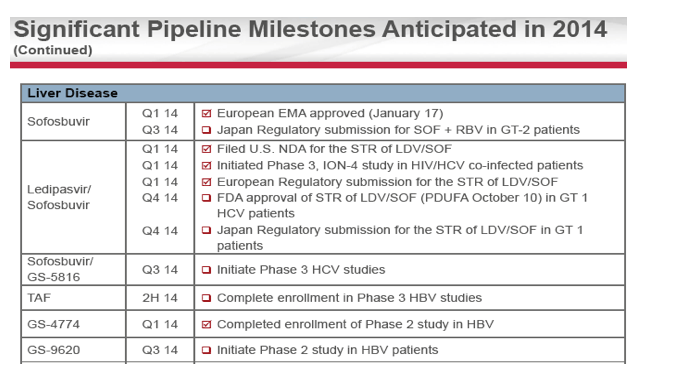

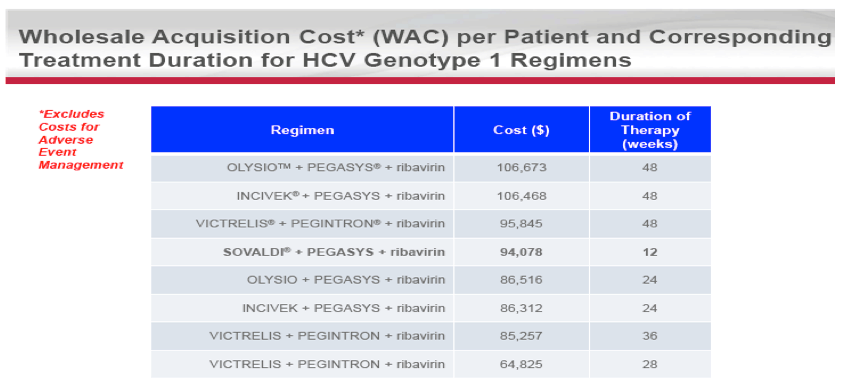
Therapy duration based on approved dosing for complete course of therapy. Follows full prescribing information recommendations for each product.
Total regimen costs assume average weight of typical patient (86.2 kg) calculated using anthropometric reference data for US adults compiled by the US Department of Health and Human Services, Centers for Disease Control and Prevention (CDC) in 2007-2010 and CDC data showing 87% of US individuals were born between 1945 and 1970 and two-thirds of this cohort are male.10,11 Ribavirin costs were based on the average generic price for capsules and tablets. Assumes no dose reduction due to adverse events and that patient takes entire regimen as indicated. Not all components may be used for the full duration. Cost for Pegasys ® based on the cost of ProClick™ autoinjectors and prefilled syringes, which are priced the same. Cost for Peg Intron® based on the cost of REDIPEN®s and single-dose kits (powder + dilutent vials), which are priced the same.
For reference only. Cost comparisons of agents do not imply comparable clinical effectiveness, safety, tolerability, or that these products have the same or similar indications or uses. Please refer to the full prescribing information for each product. Individual prescribing decisions should be made at the discretion of the provider.
· The information reflects WAC prices as reported by First Databank™ (FDB) on February 27, 2014. Manufacturers change the WAC prices of their products periodically. Current WAC prices may be obtained by contacting FDB.
· WAC = wholesaler acquisition cost, or manufacturer's published price to wholesalers; WAC represents published catalogue or list prices and may not represent actual transactional prices.
· For further information concerning pricing methodology, please refer to this section of the FDB website (http://www.fdbhealth.com/policies/drug-pricing-policy/).
· Pricing information reprinted with permission by First Databank, Inc. All rights reserved. 2014
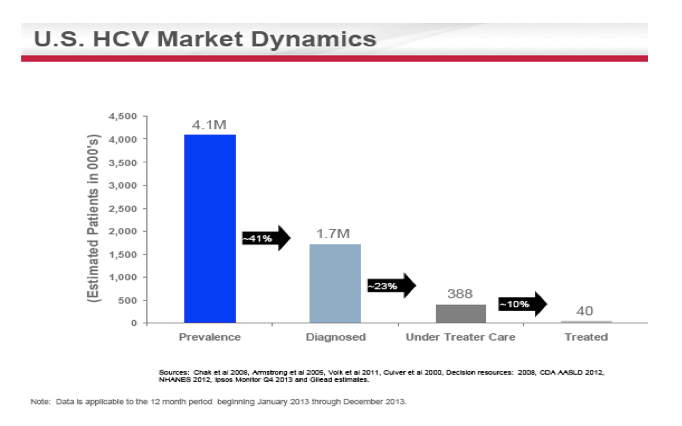
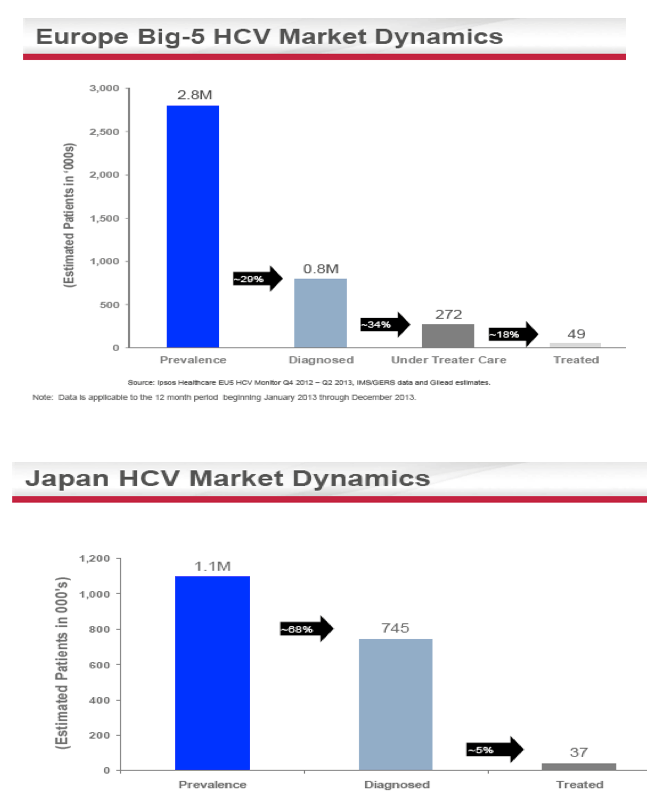
WHO, EASL Guidelines
WHO Guidelines for the screening, care and treatment of persons with hepatitis C infection - (04/09/14)
EASL Recommendations (Guidelines) on Treatment of Hepatitis C 2014 - (04/15/14)
AASLD Preparing Providers for Hepatitis Patients: Online Hepatitis Program for Primary Care Providers - (04/10/14)
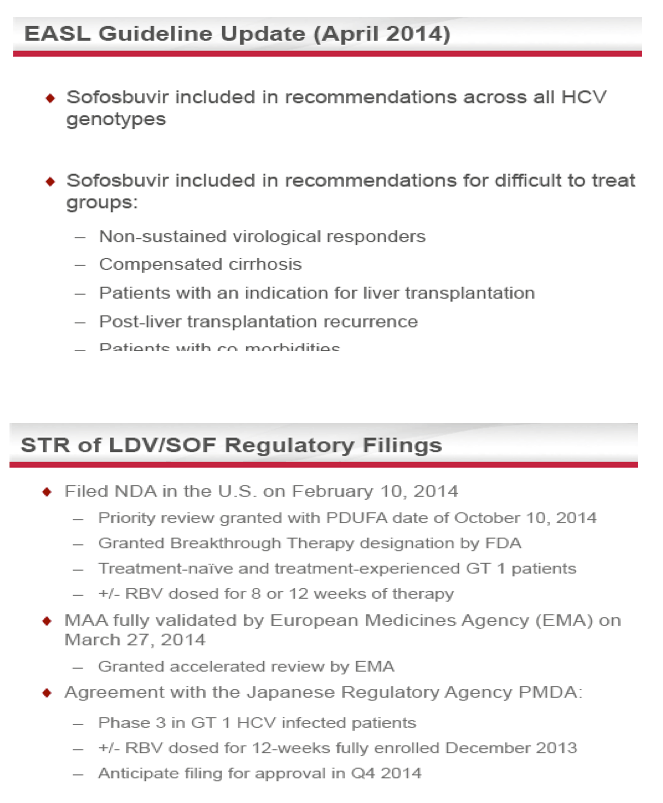
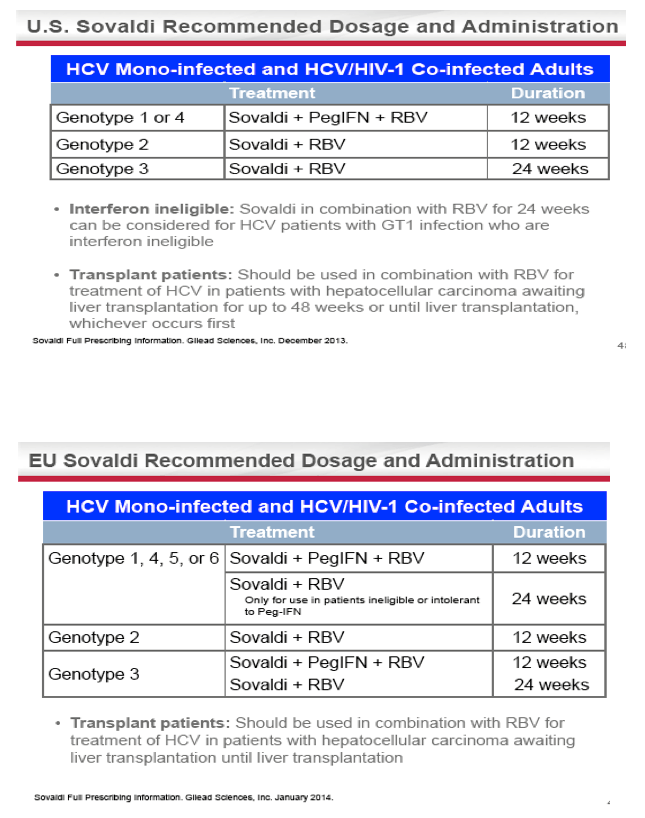

|
|
| |
| |
|
|
|